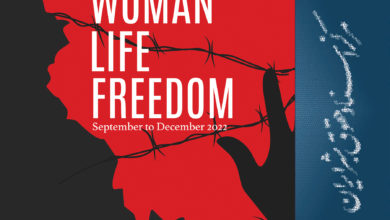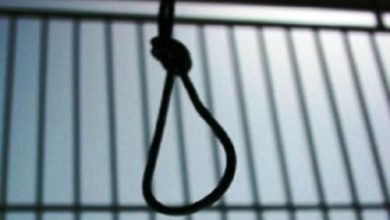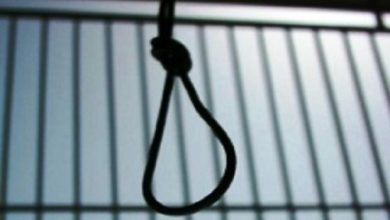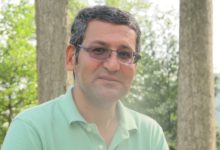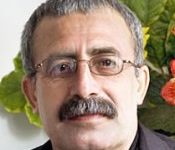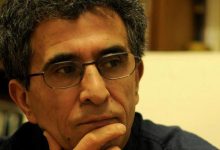Witness Statement: Sabah Nasri
Sabah Nasri, publisher of “Rujameh,” recounts his arbitrary arrest, detention and torture by Islamic Republic officials in Sanandaj and Tehran for his activities in support of Kurdish rights in Iran. Nasri also describes the regime’s treatment of Farzad Kamangar and Farhad Vakili, with whom he shared prison cells. Kamangar, Vakili and three other prisoners were executed on May 9, 2010, without notification to their families.
Name: Sabah Nasri
Place of Birth: Dehgolan, Kurdistan, Iran
Date of Birth: March 21, 1980
Occupation: Kurdish activist
Interviewing Organization: Iran Human Rights Documentation Center (IHRDC)
Date of Interview: February 22, 2011
Interviewer: IHRDC Staff
This statement was prepared pursuant to an interview with Sabah Naasri. It was approved by Sabah Nasri on May 6, 2011.
Statement
1. My name is Sabah Nasri and I was born in 1980 in the city of Dehgolan in the province of Kurdistan in Iran.
2. As a student at Tehran University, I was active with a group of Kurdish students who were studying in different universities in Tehran. We regularly met to discuss the issues facing Kurdish minorities in Iran.
3. I was arrested for these activities and spent a year and half in prison. After I was released I was prevented from continuing my education. I remained in Iran for 13-14 months after my release from prison during which time I was threatened by the security forces due to having continued my political activities in Iran and in Tehran University. The security forces and in particular the interrogator in charge of my previous case file contacted me and threatened me that if I were to continue my activities, I would be re-arrested and detained. On top of that, many of my friends had been arrested during gatherings we held in the University but I was able to escape the security forces.
4. For these reasons I came to the conclusion that it was better to leave the country than get arrested again. On February 16, 2010 I left Iran.
Detention
5. While at University, my friends and I published a magazine called “Rujameh” that I was managing director of. We obtained the publication license for this magazine from Tehran University and its circulation was three thousand copies. We distributed it in different Kurdish cities as well.
6. The magazine was shut down for four months because the Office of Culture and Islamic Guidance of Sanandaj filed a formal complaint against the magazine. After those four months, we reopened the magazine and continued to publish.
7. Eventually, on account of my activities with the magazine and also my participation in gatherings and protests on student day—December 7—and international mother language day—February 21—and generally against the Islamic Republic of Iran’s policy of repression in Kurdistan, I was arrested on July 13, 2007 along with a friend. I spent 18 months in detention.
8. During the summer vacation of 2007, I was in Sanandaj, Kurdistan, along with my friend Hedayat Ghazali when we were approached and arrested by a group of plain clothes agents. They put us in a black Peugeot and told us they were taking us to “offer some explanations” and “answer a series of questions”—a process that took 18 months!
9. Hedayat Ghazali was a Kurd as well and studied at Alameh Helli University in Tehran. He was a member of the editorial board of the magazine, wrote for the magazine, and was active in other ways as well.
10. After the arrest the agents took us to the intelligence office in Sanandaj. I was in a solitary cell in the intelligence office for 41 days. Once the interrogations ended we were moved to Sanandaj Prison. I was there for 23 days until September 13, 2007 when Hedayat and I were woken up at 2 A.M. and transferred back to the intelligence office of Sanandaj. We remained there until 6 A.M. at which point they took us to Sanandaj Airport and relocated us to Tehran.
11. Once in Tehran, I was taken to Evin prison, the general section of ward 209, room 122. I remained there for 66 or 67 days. Hedayat was in room 122. In the intelligence wards those sharing the same case file are not kept in the same room to prevent any conspiring on their part.
12. Afterward, we were again moved back to Sanandaj Prison. During all this time we had undetermined status. We remained in Sanadaj Prison for two and a half or three months until we were moved to Tehran once again.
13. This time, we were both kept in a solitary cell in ward 209 for about a week. The reason for this was because the inspector in charge of our case was on vacation and without his order they could not move us to the general ward. Finally, we were moved to ward 7 of Evin prison by order of the inspector. I remained there until the last three months of my detention.
14. Around that time Kurdish political prisoners who were held in different prisons around the country started a mass hunger strike to protest their prison conditions and the security forces and judiciary’s discriminatory manner of dealing with Kurdish prisoners. The hunger strike lasted 44 days and included clear demands. For 16 consecutive days everyone went on hunger strike together, then for the rest of it, we completed it in rotations. We reported the strike to the others on the outside via telephone and therefore, we—Hedayat and I—were moved back to ward 209 for the last three months of our detention. Finally, after 18 months of detention and completion of our sentence, we were both released.
Interrogations and Torture
15. The interrogations began from the early days when we were moved to the Sanandaj Intelligence office. Most of the questions concerned the activities we participated in at the University, especially our involvement with the magazine “Rujameh.”
16. Our “Rujameh” publication stood out from other publications at Tehran University both in appearance and content. It looked like a newspaper and was printed in color. The content was often penned by upper classmen and students in masters or PhD programs so it was denser than that of other publications. Our distribution license was exclusively for Tehran University but we also disseminated it in 16 cities in the Kurdistan region. Because our dissemination area was very large, the interrogators assumed there was an extensive and united structure backing our publication and so, they continuously asked us about the subjects, publication, dissemination and continuity of it.
17. I worked on another magazine—a weekly—at Tehran University called “Velat” along with another friend. I had executive roles in this magazine. Our work and activity alarmed the Herasat of the university[1] and they voiced their concerns over to the intelligence office in Sanandaj.
18. The University’s Herasat Office often reports to the Intelligence Office about student activists who are under surveillance. Since the city of Sanandaj filed a complaint against us for having distributed “Rujameh” in the city, they were extra sensitive to our publication. The majority of the questions in interrogation were about the publication. They even asked what publishing house we used and who owned it and other related questions. It was as if they were trying to forcefully extract something incriminating out of our answers.
19. Initially the interrogations occurred daily and always separate from one another. The length of the interrogations depended on the questions and usually spanned anywhere from one to five hours. Two interrogators conducted the first round of interrogations and once even three interrogators. But towards the end it was just one person. During the interrogations I was blindfolded and could not see the interrogator. I do not know what the main interrogator’s name was.
20. One of the interrogators at Sanandaj Intelligence Office, who is also the torturer there, is known as “Hatefi”. Of course this is his pseudonym. I heard this name later when I was in Sanandaj Prison. His name also appears on various websites. Websites claim he killed Ibrahim Lotfollahi, a young man who was tortured to death in the Sanandaj Intelligence office and who reportedly committed suicide. I could see Hatefi’s hand and some of his physical characteristics. He had a faint Turkish accent. Later when I described these characteristics to the guys in prison they agreed it must be Hatefi.
21. My torture was limited to slaps and punches. Mostly my torture was psychological because my fate was undetermined for 14 months when I did not even know what my charge was! I was transferred to Tehran a few times and returned to Sanandaj again but still did not know what my charge was. I was told I was in the interrogation phase and my case file had not been completed yet. Under Iranian law any defendant is entitled to have the charges against him explained to him within 24 hours of his arrest but this was not how my case file was conducted. They never showed me an arrest warrant. They do not really pay attention to such formalities in Iran.
22. The night we were transferred to Tehran they brought a letter written on A4 paper and folded in thirds. I was told to sign the letter without reading it. I was not willing to do that. After many arguments, the guard finally admitted that the letter was an order extending my detention. The intelligence officer himself said nothing to me even though I had insisted on knowing what the letter said. I was even told it did not matter if I signed the paper or not because ultimately they would take me with them. Finally they showed me the paper and I signed it.
1 The “Herasat” is a force of guards and morals police in universities.
23. Every two months my detention order was extended and aside from this one time when I saw and signed the paper, neither I nor Hedayat Ghazali ever saw another detention order that we could agreed to or that we could formally complain against.
24. In general, the type and degree of physical torture seems to depend on the defendant and the kind of case file he has. In our case file everything was clear and all the articles in the publication and everything about the gatherings in the university were clear. The articles were on websites and the publication had a license and was legal. For this reason I believe they did not torture us heavily since our detention did not make sense anyway. All of our activities were legal and licensed; although they said dissemination of the magazine in the cities was illegal. What I mean to say is that if they did not torture us physically it is for this specific reason. Many other defendants were tortured due to the nature of their activities and the perceived need to extract confessions from them.
25. The most significant psychological torture for us was being held in indeterminate conditions in prison that were very painful and possibly lethal. Being of indeterminate status in a system where the security officers have a lot of control over the judiciary officials and can easily ask them to issue a sentence of their choosing is very painful.
26. Another form of psychological torture was being kept in a solitary cell. This was greatly torturous to a person’s psyche.
27. There were other forms of torture, for example, for the first two weeks they would not let us call our families. In turn, they would not give a satisfactory answer to our families about our fate. After I was released from prison my family explained to me that when they would go to the intelligence office and ask about me they were told that I was not there and that they should go to the court. And at court they were told that they should go back to the intelligence office.
28. I send word to my family about my detention at the intelligence office through friends who were detained at the intelligence office and later released. Eventually the authorities told my family that both Hedayat and I were held at the intelligence office but that they should not be hopeful that I would be released from prison unscathed. In other words they told my family that they might as well recite my death rites. Later, when we were transferred to Sanandaj prison we were able to contact our families and have visitations with them. The authorities created a terrible situation for my family.
29. When one is released from the intelligence office the assumption is that his case file is completed and the officers are ready to issue an indictment and send the defendant to court. But the first time I was moved from the intelligence office I had not even been informed of my charges! They took me to court with no explanation of the charges against me.
30. Hedayat and I were brought to court but the judge did not see us so after a while, they brought us back to the prison and we remained in that indeterminate state until the night we were transferred to Tehran. I was not even told the status of my case. There was no direct torture involved but being in Sanandaj prison is torture in and of itself.
Transfer to Tehran
31. When I was transferred to Tehran they moved me to hall number 10 on the first day. The second floor of ward 209 has solitary cells. There are eleven hallways there and in each are eight solitary cells. The prison was relatively empty when we were brought there. In hallway number 10 all the solitary cells were opened and the main door to the main hallways was locked. Five prisoners were placed there and I was the sixth.
32. Everyone there, except for one political prisoner, had committed financial crimes. Unless I am mistaken his name was Aydin. He was a leftist and had thrown eggs at the Swiss embassy in Iran. He had written 80 pages of insults relating to Iran and the USA and had written about the monetary connection between Iran and the USA, concluding that the Islamic Republic of Iran was a tool in the hand of American consumerism. Then, he handed his writings to the Swiss embassy and had thrown eggs at the building. So the embassy police arrested him. The financial criminals of ward 209 are also in a way political prisoners because in the end they are connected to the economic “mafia” of the regime.
33. About a month later they moved me to room 122 in Ward 209 of Evin prison where mostly financial criminals were housed. There were three or four members of the Kurdish Democratic Party of Iran (KDPI) there as well. One of those KDPI members received a suspended sentence and has since been released but another one, Meysam Rudaki, was sentenced to two or three years in prison and is still there.
34. There also are quite a few prisoners for drug offenses in ward 209. Usually they have heavy crimes. For example, there were people in that ward who were caught dealing over a thousand or 1,200 kilos of opium. Others were arrested for trafficking cocaine.
35. At that time, in 2007, there were only a few people in ward 209 of Evin prison. There was a man named Kayvan who was charged with activity with the Al-e Yasin group that his brother headed. Kayvon himself was not a member but was accused of funding his brother. He denied the accusation. He was later released on 500 thousand dollar bail and I have no news of him.
36. I was not tortured in ward 209 of Evin prison. Their behavior towards us was much better and more respectful than that of the interrogators at Sanandaj and their interrogation techniques were more professional and modern. The interrogators’ knowledge about Kurdish movements was much better compared to the Sanandaj interrogators. My interrogation there took between one to four or five hours, like it did in Sanandaj. However, unlike Sanandaj, there were no insults or beatings involved.
37. My interrogation in Tehran focused on my activities with the magazine Rujameh. Piece by piece they asked about the magazine, for example, the layout and printing, and the manner of distribution. They even brought the articles and asked who wrote them? Who helped the magazine and where did you get your funding from? They asked the same questions constantly and every time I was interrogated they would repeat the questions. I believe this was to see if I would contradict myself.
38. Initially I had two people interrogating me in Tehran, but then eventually only one person came. One of them was called “doctor.” He was Farzad Kamagar’s[2]interrogator as well and later on when I shared a cell with Farzad in ward 209, Farzad told me that the name of the interrogator was “Reza’””. The third time I went to ward 209, Farzad and I were there together for three months.
39. Reza’i’s information about the Kurds was pretty extensive and in particular he knew the Kurdistan Workers’ Party (P.K.K.)[3] very well. He was not a Kurd himself and had a faint Arabic accent. I do not know where he was from but they said that he is a Turk. He spoke very slowly and in a measured fashion. He followed old methods of interrogation techniques, namely a harsh approach. A number of other interrogators follow a softer method in dealing with the suspect—they try to bond with the suspect through verbal and psychological techniques so as to get closer to the suspect and extract necessary information from him.
40. To illustrate, the first type of interrogator, the so-called “Reza’””, would pose a question and if he didn’t get an answer, he would leave and not return for a month or so. Instead, the second interrogator tried to explore the avenue of friendship. When Reza’i was interrogating we were blindfolded and sat facing the wall; but the second interrogator had a soft approach—he allowed the blindfold to be removed and sat face to face with the suspect while questioning and interrogating.
41. Of course the second interrogator had certain antics too like offering cigarettes and fruit to the suspect in the hopes this would curry favor with the suspect and get him to help him. In terms of appearance, he was well put together and well dressed and tried to appear kind and friendly. He did not have the appearance of a typical interrogator. He said that he is not like the others and thinks that the youth and the bright students in prison should be accorded respect.
42. Unfortunately, this interrogator was very successful. Later when I spoke with some of the defendants that he interrogated, I realized he was able to persuade them to speak. He was able to get them to incriminate themselves—then he closed their case files in the harshest manner possible and had very heavy sentences issued against them.
2 Farzad Kamangar was a Kurdish teacher and activist executed by Iranian authorities on May 9, 2010 for “moharebeh” (literally “waging war against God”) and other offenses that carry a sentence of capital punishment. Kamangar was executed along with four other activists, three of them ethnic Kurds: Shirin Alamhooee, Ali Haidarian and Farhad Vakili. The fifth, Mehdi Islamian, was executed for membership in an armed pro-monarchist group and on charges of endangering national security. Following the executions, human rights groups voiced concerns over the lack of due process accorded the five activists in trial and sentencing, and reports that the activists were brutally tortured in detention.
3 The Kurdistan Workers’ Party (PKK) is a Kurdish militant separatist group. Historically the PKK has been very active in Iran’s neighboring country of Turkey. The PKK is listed as a terrorist organization in Iran and many other countries.
43. This second interrogator introduced himself with a different name to each defendant. Tome, he introduced himself as “Ali” while he introduced himself as “Saeed” to some of the others.
Transfer Back to Sanandaj Prison
44. After another 67 days, I was transferred to Sanandaj prison again. My case file was deemed ‘unauthorized for processing’ in Sanandaj—apparently because my file said the location of my commission of the crime was in Tehran, I was to be transferred to Tehran. But then in Tehran I was told that since the arrest took place in Kurdistan I needed to be transferred back to Sanandaj.
45. Either way, after spending three months in Sanandaj prison, the case file was labeled as ‘unauthorized for processing.’ According to the law, the officials at Sanandaj prison were correct because defendants must be tried in the jurisdiction where the crime occurred. Their eventual disagreement caused the case file to go to the administrative branch of the Supreme Court in Qom.
46. These events took several months and during this time, there was a stream of death sentences issued for Kurdish political activists. About ten to twelve persons in Kurdistan were sentenced to very heavy prison terms and even execution. Therefore, our families were extremely concerned about our fates and tried every avenue to save us. Finally the administrative branch of the Supreme Court concurred with the Sanandaj Court and we were transferred to Tehran.
47. Because our case had been moved from the prosecutor’s office to the court, the second time we were transferred to Tehran our transfer was not conducted by the intelligence office. Previously when the transfer was done by the intelligence office, all the relocations and transportations were coordinated between the intelligence offices of the two cities and we were easily transported with an airplane. However, this time law enforcement transferred us to Tehran on a bus while handcuffed.
48. When we finally reached Tehran, no one came to get us since there was no prior coordination and planning. We had no choice but to spend the night at my friend’s house accompanied by the security officer who was escorting us. No office would claim us and, to add to the disorganization, it was the weekend.
49. Because the inspector in charge of our case, Mr. Rasekh, was on vacation, no intelligence office could claim us. Our case had become so unnecessarily complicated that no one other than the inspector in charge of our case could make heads or tails of it. For that reason we had to wait for him to return from vacation and issue our order of transfer. After seven days Rasekh came back and ordered our transfer to General Ward number 7 of Evin prison. I was in Ward 7 for 7-8 months where I was in the same room with Farhad Vakili—who was executed along with Farzad Kamangar.
50. After that a coordinated hunger strike took place in Iranian prison, including a few prisons in Kurdish towns that lasted 44 days. We were transferred back to Ward 209 for having participated in those strikes and I spent my last 3 months of detention there alongside Farzad Kamangar.
Sharing a cell with Farhad Vakili
51. Farhad Vakili and three others, Farzad Kamangar, Ali Haidarian and another person who escaped arrest, shared a common case file. Farhad Vakili was not arrested with the other two but nonetheless they shared a case file and were charged with membership in the P.K.K. They were charged with many things—however the ministry of intelligence had no evidence to prove those charges in the case file and the defendants had not confessed to them either. Their case file was very complicated and ambiguous. Eventually, the Intelligence Office supported the claims using reports from branches of its intelligence offices in the cities of the prisoners’ residences, Sanandaj and Kamyaran, and concluded that according to the reports from their own offices, they were guilty and the court accepted this claim. This is how they received a death sentence.
52. Farhad Vakili said many times that he was severely tortured. He had a congenital defect in his right leg. He said they tied his right foot to a chair with a rope and tied his left foot to the door handle and would open and close the door repeatedly. This caused him so much trauma and pain that he practically reached the point of unconsciousness.
53. When I shared a cell with Farhad Vakili a few months had passed since he was captured and the marks of torture on his body had healed. But the situation of his case file clearly showed that he was tortured a lot.
54. Farhad Vakili was very respected by other prisoners. He was popular among his cellmates and they sought his counsel on matters. I later heard he was put in charge of the ward he was in to be the contact between the prisoners and the guards. Usually the older prisoners and those liked by everyone are put in those positions. The fact that he was in that position reflected the degree of his popularity among the prisoners. He tried to mediate differences between prisoners in a liberal and fair manner and his words were accepted by all. At the time, his death sentence had been issued by the lower court and went to the Supreme Court for approval and the Article 18 process that reviews the ruling.
55. I think Farzad Kamangar, Ali Haidarian and Farhad Vakili were arrested in 2006 and sentenced in 2007. These three spent some time in the Rajaishahr prison. Farzad was later transferred to Evin prison, but Ali Haydarian and Farhad Vakili remained in Rajaishahr prison. Later on they were also transferred to Evin and kept in Ward 209. When the strike took place (Farhad was amongst the striking prisoners too) Hedayat Ghazali and I were again moved to ward 209.
56. I was kept for a few days in a room with two drug traffickers, both ethnic Baluchs, who were arrested with opium. After three days I asked the interrogator to be moved to general ward 121 or 122. The interrogator Ali transferred me to Ward 121 where Farzad Kamangar was being held as well. We were together for roughly three months until they moved him back to Rajaishahr prison.
Sharing a Ward with Farzad Kamangar
57. Farzad Kamangar was distinctly different than all other prisoners I met in Tehran or Sanandaj, no matter their crimes or personalities. Upon meeting Farzad, you instantly realized from his demeanor and speech that he was special. He was very charismatic and all the prisoners, no matter their crimes, loved him.
58. Although the 121 room where Farzad was only had 10 beds, 16 prisoners were kept there and I was the 17th. Most of them were charged with crimes related to land disputes such as unlawful possession and the like. Around seven or eight of these prisoners had held authoritative positions in the government, like Majlis members or City council members and they were all from Ahvaz. Doctors Arash and Kamyar Alaei, the two doctors who worked on AIDS were also there. One man was from the Islamic Republic of Iran Broadcasting (IRIB) and one man there was charged with having contact with Al Qaeda. Except for the six or seven people there on political charges, everyone else was charged with the sale of drugs or the commission of financial crimes.
59. Although the residents of that room did not have much in common, they all loved Farzad. Farzad had an interesting and attractive character. I had heard a lot about Farzad, both through his imprisoned teacher friends and colleagues in Sanandaj prison and at Evin prison prior to meeting him. There was a lot of talk about him. One could not believe that Farzad had a death sentence issued against him. He was a kind, pure hearted human whose virtues were praised by all. He was very cheerful, energetic and full of spirit and would constantly boost the morale of others. Even the guards had a special sensitivity towards him.
60. Farzad Kamangar was tortured with intent to kill, much worse than the treatment of Farhad Vakili and Ali Haidarian. He described his torture in a letter. He said the first day that he and Ali Haidarian were arrested they were taken to an unknown location and a group of six or seven men just beat them, without asking any questions. He said that when he inquired about that location later, he discovered that apparently it was the office of the security police. Farzad said that when they beat him with a electric baton he passed out and they kept pouring cold water on him to bring him back to consciousness at which point they punched and kicked him and used batons to hit his sensitive body parts.
61. Farzad Kamagar was then moved to ward 209 where, according to him, he was not tortured as much and when tortured, it was not very severe. Afterward, the authorities took him to the Intelligence Office of Kermanshah where he was violently tortured. When he described the torture it was evident that it affected him profoundly—it made him a stronger person. His strength was reflected in the boldness of his speech.
62. Farzad told me that while he was held in Kermanshah’s intelligence office, for 18 days he was kept in a room that was fashioned in the shape of a coffin inside the wall. In that room, he could not sit or stand and could only lie in a sleeping position. He was kept completely naked for the duration of those 18 days. He said that on those 18 days, for 14-16 hours a day, a radio was turned to the Payam radio station (which broadcasts a 24 hour traffic report) and this was extremely torturous for him. He was only taken out of this coffin-like room for interrogation, where he then was severely tortured by a group of people.
63. Farzad described one method of torture called “football game” in which a few people circled around him in a room and pushed him in each other’s direction for a long time until he had vertigo and felt nauseous. While pushing him back and forth, they also ridiculed him and said offensive things to him. During interrogations, in order to demoralize and ridicule him, the interrogators insulted his family and leaders of various Kurdish parties. Farzad told me his torturers had a whip made of leather straps called Zulfaghar. Every time interrogators brought Farzad to the interrogation room, they brought Zulfaghar too.
64. One time in the interrogation room, while Farzad was blindfolded, interrogators stripped him naked and threatened to rape him with a baton. The interrogators tried different ways of interrogating Farzad, all unsuccessful, and they did not know how to force him to confess. He withstood all types and forms of torture.
65. To further add to the injustice, Farzad’s case file was spotless. Even Farzad’s attorney Mr. Bahrami once said that if the authorities brought even one valid document to prove the charges pinned on Farzad, he would tear up his practicing license, that how confident he was in Farzad’s innocence of the allegations against him.
Trial and Sentencing
66. After 14 months of legal limbo, in 2008 I went to Branch 13 of the Tehran Revolutionary Court presided over by Judge Sadat. Hedayat Ghazali and I went to court together.
67. Our trial had been delayed four times and during this period, the case file was in the hands of Judge Sadat. Even still, the fourth time when we were summoned to court and when Sadat brought out the case file, he asked my name and although I repeated it three times, he still did not understand what my name was. Admittedly, my name, Sabah, is not very common in cities with a majority population of Fars decent however this error indicated to me that the judge had not even bothered to read my file. He then asked my attorney whether I was a foreigner or not! From this, it was clear he had not even read the first page on the case file containing my biographical details that indicated I was from Kurdistan and a student in Tehran.
68. At that point it was quite clear that the judge was merely reading the ruling handed to him by the prosecutor or the intelligence office. Then he asked me, “You have been in prison for 14 months, how come you have not been released on bail yet?” I said “Yes! This is the question I have of you! Why has no bail been issued for us yet?” Again, it was clear from his conduct and his questions that he had not even read the case file.
69. The representative of the prosecutor came and read the indictment and requested the maximum penalty for us. We stated our defense. In fact, our defense made no sense at all. When after 14 months of stay in prison we had effectively served our sentences, defending ourselves bore no meaning at all.
70. I was sentenced to two years’ imprisonment. After I appealed the sentence, the appeals court sentenced me to 1.5 years’ imprisonment and a six month suspended imprisonment sentence served over 5 years. I was ultimately charged with propaganda against the regime and participation in illegal gatherings.


